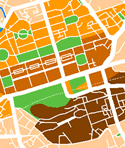| |
|
Edinburgh City History
The historic significance of Edinburgh is plain to see for anyone walking the city streets for any length of time. Striking monuments adorn the many cobbled ‘wynds’ and ‘closes’, and there are now almost 5000 listed buildings in the city.
But where did it all begin ?
During the Iron and Bronze ages, stone settlements scattered the Pentland Hills which overlook the Edinburgh of today. There were also inhabited areas around the future site of Holyrood Palace and Craiglockhart Hill. Over time the Castle Rock was most probably used as a lookout post, guarding against invasion from the north. Up until the year 1018 the area was part of The Kingdom of Northumbria and ruled by King Edwin for part of this time. The area became known as ‘Din Eidyn’ translated as ‘Edwin’s Fort’, and over time became ‘Edwinesburch’ and later ‘Edinburgh’.
By the 12th century, Edinburgh was an established settlement along with Holyrood to the East. The port of Leith soon prospered and in 1603 the first Parliament of Scotland was formed, which convened in Edinburgh Castle’s Great Hall.
In the aftermath of the Jacobite rebellion Edinburgh was expanded in honour of King James VI and the royal family. With the King’s Flag as a template and the royal’s names as inspiration, several new streets were constructed : Castle Street, George Street, Princes Street, Frederick Street, Hanover Street, Queen Street, Rose Street and Thistle Street.
Later, the Nor Loch was drained (now the Princes Street gardens) and the New Town was formed. During the harshest winters of past, the Nor Loch became entirely frozen over and many works of art can be found depicting people walking and skating on the ice. Incidentally, as Edinburgh and indeed the whole of Scotland still suffer long winters, the city is one of the largest consumers of snow shovels .
Edinburgh eventually industrialised, earning the nickname ‘Auld Reekie’, and became a bustling whaling and trade port. Over time Leith grew to be one of the more exclusive areas of the city, where you will find some of the finest hotels in Edinburgh, such as Malmaison on the river front. Glasgow soon overtook Edinburgh’s industrial scale but ‘Din Eidyn’ became and remains Scotland’s cultural epicentre and of course, the nation’s capital.
Edinburgh City centre is essentially split in two, with the Princes Street Gardens acting as a North-South divide between and .
The Map on the right of this page shows the New and Old Towns of Edinburgh boundaries. The New Town as it happens is where you will find the offices of The Law Society of Scotland. The society regulates all solicitors in Scotland and has done so for over 60 years.
If you are planning a trip to Edinburgh, why not extend your stay in Scotland by taking one of the many available tours to famous attractions such as Loch Ness, The Scottish Highlands, Isle of Skye, Glasgow and The Scottish Borders.
Written by Shaun Flanagan
|
 |
